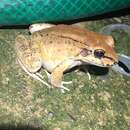Comprehensive Description
provided by Smithsonian Contributions to Zoology
Leptodactylus rhodonotus (Günther), 1868
Cystignathus rhodonotus Günther, 1868:481. [Type-locality: Chyavetas, Peru. Holotype: BMNH 1947.2.17.39, juvenile.]
Gnathophysa rubido Cope, 1874:128. [Type-locality: Moyabamba, San Martin, Peru. Lectotype: MCZ 4780, adult male.]
DIAGNOSIS.—Specimens of rhodonotus have a distinct dark outlined dorsolateral fold from the eye to the sacrum or groin. This condition occurs in some or all individuals of fallax, flavopictus, labyrinthicus, pentadactylus, knudseni, rhodomystax, rugosus, and stenodema. Most rugosus lack dorsolateral folds; when folds are present in rugosus, they are interrupted, contrasting with the continuous folds of rhodonotus. Leptodactylus rhodonotus is a moderate-sized species (maximum adult SVL 90 mm) with two spines per thumb in males; fallax, labyrinthicus, pentadactylus, and knudseni are large species (minimum adult SVL 97 mm) with one spine per thumb in males. Leptodactylus flavopictus is also a large species (minimum adult SVL 112 mm) with smooth upper tibial surfaces contrasting with the tuberculate upper tibial surfaces of rhodonotus. The posterior surface of the thigh is variously mottled in rhodonotus but never has the pattern of discrete, distinct light spots on a dark background found in rhodomystax. Leptodactylus rhodonotus is a smaller species (males 54–79 mm SVL, females 67–90 mm SVL) with male thumb spines present; stenodema is a larger species (males 83–100 mm SVL, females 82–100 mm SVL) lacking male thumb spines. The dorsum of rhodonotus often has a distinctive pattern; the dorsum of stenodema is patternless.
ADULT CHARACTERISTICS (N=87).—Dorsum uniform, with scattered small dots or blotches to complex lattice network (Figure 1, C, I); lip with dark triangular patterns, uniform, or rarely with a distinct light stripe (Figure 2, A–C, E, L, M); posterior surface of thigh almost uniform, mottled, or with contrasting light and dark pattern (Figure 3, A, C, D, P); upper tibia with distinct or indistinct bars or uniformly patterned (Figure 4, D, E); a pair of dark outlined dorsolateral folds from eye to sacrum or groin; dark outlined fold from eye over tympanum to shoulder; dark outlined fold from above tympanum to side of body present or absent, continuous or interrupted; male thumb with two spines per hand; male chest usually with spines, all specimens 65 mm SVL or larger with spines; upper tibial and distal tarsal surfaces with scattered to many white- or black-tipped tubercles; sole of foot usually with scattered black-tipped tubercles, sometimes smooth or with scattered white tubercles; female SVL 75.0±5.8 mm, maximum 89.5 mm, male 67.8±6.7 mm, maximum 79.0 mm; female interorbital distance/head length ratio 0.20±0.02, male 0.20±0.02; female eye-nostril distance/head length ratio 0.24±0.01, male 0.24±0.02; female head length/SVL ratio 0.35±0.01, male 0.36±0.01; female head width/SVL ratio 0.37±0.02, male 0.37±0.02; female femur/SVL ratio 0.40±0.03, male 0.40±0.02; female tibia/SVL ratio 0.42±0.02, male 0.43±0.02; female foot/SVL ratio 0.45±0.02, male 0.46±0.03.
DISTINCTIVE COLORS IN LIFE.—Ventral hind limb surfaces are often pinkish orange. The tips of the digits and the subarticular tubercles are orange (from field notes of J. P. Bogart, R. Etheridge, and D. B. Wake).
LARVAL CHARACTERISTICS.—Eye diameter 9–12 percent head-body length; oral disk subterminal; oral disk entire; oral disk width 17–24 percent head-body length; oral papilla gap 46–62 percent oral disk width; split tooth row anterior to beak just less than 1/2 length entire tooth row anterior to beak; 150–167 denticles in split tooth row anterior to beak; tooth row formulae or ; head-body length 34–37 percent total length; maximum length stage 40, 59 mm.
MATING CALL.—Unknown.
KARYOTYPE.—Diploid number 22, 7 pair median, 3 pair submedian, 1 pair subterminal; secondary constructions in chromosome pair 2 and 7 (Bogart, 1974).
DISTRIBUTION (Figure 16).—This species is known from a limited geographic area in Amazonian Peru and Bolivia.
BOLIVIA. COCHABAMBA: Tarate (UMMZ 68187(3)).
PERU. CUZCO: Quince Mil (FMNH 140470, 140508, 141035); Río Cosñipata, 4 kw SW Santa Isabel, 1700 m (KU 138883). HUANUCO: Chinchao, 5700’ (FMNH 3544); Divisoria, 1600 m (FMNH 56308–13); Exito, valley of the Cayumba (FMNH 5587); Tingo Maria (USNM 196003–11(5)); about 12 km (by Huanuco Rd) S of Tingo Maria, Sector Cueva de las Pavas, Parque National de la Bella Durmiente (USNM 196002). JUNIN: Chancharia, on Río Perene, 2.5 hrs by motor boat below Pampa Silva and approximately 5 mi above entrance of Río Ipok, about 700 m (USNM 196001); Chanchamayo (FMNH 40582–83, 134511); San Ramon, 800 m (KU 135506, MCZ 22823, 22825–26); Tarma, valley of Vitoc R 900 m (FMNH 36832–37). LORETO: Iparia (MCZ 75039–40). MADRE DE DIOS: Avispal (FMNH 140923); La Pampa (FMNH 40289). PASCO: Iscozazin Valley, Chontilla (LACM 40608–47). PUNO: Bella Pampa (FMNH 40280); Camp 4 (FMNH 40287–88); Juliaca (AMNH 6129); Sagrario, Río Quitún (FMNH 40270–79); Santo Domingo (FMNH 40281–86). SANDIA: Tambopata, San Juan (FMNH 64930–32). SAN MARTÍN: Moyobamba (MCZ 4780); Tocache Nuevo, Río Huallaga (USNM 196000).
- bibliographic citation
- Heyer, W. Ronald. 1979. "Systematics of the pentadactylus species group of the frog genus Leptodactylus (Amphibia, Leptodactylidae." Smithsonian Contributions to Zoology. 1-43. https://doi.org/10.5479/si.00810282.301

